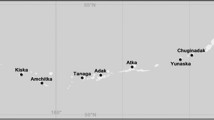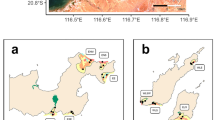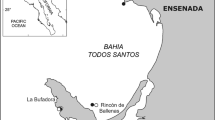Abstract
Identifying spatial scales of variation in natural communities and the processes driving them is critical for obtaining a predictive understanding of biodiversity. In this study, we focused on diverse communities inhabiting productive kelp forests on shallow subtidal rocky reefs in southern California, USA. We combined long-term community surveys from 86 sites with detailed environmental data to determine what structures assemblages of fishes, invertebrates and algae at multiple spatial scales. We identified the spatial scales of variation in species composition using a hierarchical analysis based on eigenfunctions, and assessed how sea surface temperature (SST), water column chlorophyll, giant kelp biomass, wave exposure and potential propagule delivery strength contributed to community variation at each scale. Spatial effects occurring at multiple scales explained 60% of the variation in fish assemblages and 52% of the variation in the assemblages of invertebrates and algae. Most variation occurred over broad spatial scales (> 200 km) consistent with spatial heterogeneity in SST and potential propagule delivery strength, while the latter also explained community variation at medium scales (65–200 km). Small scale (1–65 km) community variation was substantial but not linked to any of the measured drivers. Conclusions were consistent for both reef fishes and benthic invertebrates and algae, despite sharp differences in their adult mobility. Our results demonstrate the scale dependence of environmental drivers on kelp forest communities, showing that most species were strongly sorted along oceanographic conditions over various spatial scales. Such spatial effects must be integrated into models assessing the response of marine ecosystems to climate change.







Similar content being viewed by others
References
Airoldi L (2003) The effects of sedimentation on rocky coast assemblages. Oceanogr Mar Biol 41:161–236
Anderson MJ, Crist TO, Chase JM et al (2011) Navigating the multiple meanings of β diversity: a roadmap for the practicing ecologist. Ecol Lett 14:19–28
Bell TW, Cavanaugh KC, Reed DC, Siegel DA (2015) Geographical variability in the controls of giant kelp biomass dynamics. J Biogeogr 42:2010–2021
Bell TW, Cavanaugh KC, Siegel DA (2017) SBC LTER: time series of quarterly NetCDF files of kelp biomass in the canopy from Landsat 5, 7 and 8, 1984 - 2016 (ongoing). St. Barbar. Coast. LTER
Bjørnstad ON, Falck W (2001) Nonparametric spatial covariance functions: estimation and testing. Environ Ecol Stat 8:53–70
Blanchet FG, Legendre P, Borcard D (2008) Forward selection of explanatory variables. Ecology 89:2623–2632
Blanchette CA, Helmuth B, Gaines SD (2007) Spatial patterns of growth in the mussel, Mytilus californianus, across a major oceanographic and biogeographic boundary at Point Conception, California, USA. J Exp Mar Biol Ecol 340:126–148
Blanchette CA, Raimondi PT, Broitman BR (2009) Spatial patterns of intertidal community structure across the California Channel Islands and link to ocean temperature. In: Proceedings of the 7th California Islands Symposium. Institute for Wildlife Studies, Arcata, CA, pp 161–173
Borcard D, Legendre P (2002) All-scale spatial analysis of ecological data by means of principal coordinates of neighbour matrices. Ecol Model 153:51–68
Borcard D, Legendre P, Drapeau P (1992) Partialling out the spatial component of ecological variation. Ecology 73:1045–1055
Borcard D, Legendre P, Avois-Jacquet C, Tuomisto H (2004) Dissecting the spatial structure of ecological data at multiple scales. Ecology 85:1826–1832
Broitman BR, Kinlan BP (2006) Spatial scales of benthic and pelagic producer biomass in a coastal upwelling ecosystem. Mar Ecol Prog Ser 327:15–25
Byrnes JEK, Reed DC, Cardinale BJ et al (2011) Climate-driven increases in storm frequency simplify kelp forest food webs. Glob Chang Biol 17:2513–2524
Caselle JE, Rassweiler A, Hamilton SL, Warner RR (2015) Recovery trajectories of kelp forest animals are rapid yet spatially variable across a network of temperate marine protected areas. Sci Rep 5:14102
Castorani MCN, Reed DC, Alberto F et al (2015) Connectivity structures local population dynamics: a long-term empirical test in a large metapopulation system. Ecology 96:3141–3152
Cavanaugh KC, Siegel DA, Reed DC, Dennison PE (2011) Environmental controls of giant-kelp biomass in the Santa Barbara Channel, California. Mar Ecol Prog Ser 429:1–17
Cavanaugh KC, Kendall BE, Siegel DA et al (2013) Synchrony in dynamics of giant kelp forests is driven by both local recruitment and regional environmental controls. Ecology 94:499–509
Chase JM (2010) Stochastic community assembly causes higher biodiversity in more productive environments. Science 328(80):1388–1391
Chase JM, Myers JA (2011) Disentangling the importance of ecological niches from stochastic processes across scales. Philos Trans R Soc B Biol Sci 366:2351–2363
Chase JM, Kraft NJB, Smith KG et al (2011) Using null models to disentangle variation in community dissimilarity from variation in α-diversity. Ecosphere 2:art24
Coleman MA, Cetina-Heredia P, Roughan M et al (2017) Anticipating changes to future connectivity within a network of marine protected areas. Glob Chang Biol 23:3533–3542
Connell JH (1971) On the role of natural enemies in preventing competitive exclusion in some marine animals and in rain forest trees. In: Den Boer PJ, Gradwell GR (eds) Dynamics of populations. PUDOC, pp 298–312
Dayton PK (1971) Competition, disturbance, and community organization: the provision and subsequent utilization of space in a rocky intertidal community. Ecol Monogr:351–389
Dayton PK, Currie V, Gerrodette T et al (1984) Patch dynamics and stability of some california kelp communities. Ecol Monogr 54:254–289
Declerck SAJ, Coronel JS, Legendre P, Brendonck L (2011) Scale dependency of processes structuring metacommunities of cladocerans in temporary pools of High-Andes wetlands. Ecography 34:296–305
Dong CM, Idica EY, McWilliams JC (2009) Circulation and multiple-scale variability in the Southern California Bight. Prog Oceanogr 82:168–190
Dornelas M, Gotelli NJ, McGill B et al (2014) Assemblage time series reveal biodiversity change but not systematic loss. Science 344(80):296–299
Dray S, Legendre P, Peres-Neto PR (2006) Spatial modelling: a comprehensive framework for principal coordinate analysis of neighbour matrices (PCNM). Ecol Model 196:483–493
Dray S, Pélissier R, Couteron P et al (2012) Community ecology in the age of multivariate multiscale spatial analysis. Ecol Monogr 82:257–275
Dungan JL, Perry JN, Dale MRT et al (2002) A balanced view of scale in spatial statistical analysis. Ecography (Cop) 25:626–640
Ebeling AW, Larson TJ, Alevizon WS (1980) Habitat groups and island-mainland distribution of kelp-bed fishes off Santa Barbara, California. In: Power DM (ed) Multidisciplinary symposium on the California Islands. Santa Barbara Museum of Natural History, Santa Barbara
Edwards MS (2004) Estimating scale-dependency in disturbance impacts: El Niños and giant kelp forests in the northeast Pacific. Oecologia 138:436–447
Flinn KM, Gouhier TC, Lechowicz MJ, Waterway MJ (2010) The role of dispersal in shaping plant community composition of wetlands within an old-growth forest. J Ecol 98:1292–1299
Fraschetti S, Terlizzi A, Benedetti-Cecchi L (2005) Patterns of distribution of marine assemblages from rocky shores: evidence of relevant scales of variation. Mar Ecol Prog Ser 296:13–29
García Molinos J, Halpern BS, Schoeman DS et al (2016) Climate velocity and the future global redistribution of marine biodiversity. Nat Clim Chang 6:83–88
Graham HM (2004) Effects of local deforestation on the diversity and structure of Southern California giant kelp forest food webs. Ecosystems 7:341–357
Grober-Dunsmore R, Pittman SJ, Caldow C et al (2009) A landscape ecology approach for the study of ecological connectivity across tropical marine seascapes. In: Nagelkerken I (ed) Ecological connectivity among tropical coastal ecosystems. Springer, Dordrecht, pp 493–530
Harms S, Winant CD (1998) Characteristic patterns of the circulation in the Santa Barbara Channel. J Geophys Res 103:3041–3065
Henderikx Freitas F, Siegel DA, Maritorena S, Fields E (2017) Satellite assessment of particulate matter and phytoplankton variations in the Santa Barbara Channel and its surrounding waters: role of surface waves. J Geophys Res Ocean 122:355–371
Hubbell SP (2001) The unified neutral theory of biodiversity and biogeography. Princeton University Press, Princeton
Hughes TP, Baird AH, Dinsdale EA et al (1999) Patterns of recruitment and abundance of corals along the Great Barrier Reef. Nature 397:59–63
Hughes BB, Beas-Luna R, Barner AK et al (2017) Long-term studies contribute disproportionately to ecology and policy. Bioscience 67:271–281
Jones MM, Tuomisto H, Clark DB, Olivas P (2006) Effects of mesoscale environmental heterogeneity and dispersal limitation on floristic variation in rain forest ferns. J Ecol 94:181–195
Kenner MC, Estes JA, Tinker MT et al (2013) A multi-decade time series of kelp forest community structure at San Nicolas Island, California (USA). Ecology 94:2654
Kinlan BP, Gaines SD (2003) Propagule dispersal in marine and terrestrial environments: a community perspective. Ecology 84:2007–2020
Koenigs C, Miller RJ, Page HM (2015) Top predators rely on carbon derived from giant kelp (Macrocystis pyrifera). Mar Ecol Prog Ser 537:1–8
Krumhansl KA, Okamoto DK, Rassweiler A et al (2016) Global patterns of kelp forest change over the past half-century. Proc Natl Acad Sci 113:13785–13790
Kushner DJ, Rassweiler A, McLaughlin JP, Lafferty KD (2013) A multi-decade time series of kelp forest community structure at the California Channel Islands. Ecology 94:2655
Laliberté E, Paquette A, Legendre P, Bouchard A (2009) Assessing the scale-specific importance of niches and other spatial processes on beta diversity: a case study from a temperate forest. Oecologia 159:377–388
Legendre P (1993) Spatial autocorrelation: trouble or new paradigm? Ecology 74:1659–1673
Legendre P, Anderson MJ (1999) Distance-based redundancy analysis: testing multispecies responses in multifactorial ecological experiments. Ecol Monogr 69:1–24
Legendre P, Gallagher ED (2001) Ecologically meaningful transformations for ordination of species data. Oecologia 129:271–280
Legendre P, Legendre L (2012) Numerical ecology. Elsevier, Third Edit
Legendre P, De Cáceres M, Borcard D (2010) Community surveys through space and time: testing the space–time interaction in the absence of replication. Ecology 91:262–272
Legendre P, Oksanen J, ter Braak CJF (2011) Testing the significance of canonical axes in redundancy analysis. Methods Ecol Evol 2:269–277
Leibold MA, McPeek MA (2006) Coexistence of the niche and neutral perspectives in community ecology. Ecology 87:1399–1410
Leibold MA, Holyoak M, Mouquet N et al (2004) The metacommunity concept: a framework for multi-scale community ecology. Ecol Lett 7:601–613
Lester SE, Gaines SD, Kinlan BP (2007) Reproduction on the edge: large-scale patterns of individual performance in a marine invertebrate. Ecology 88:2229–2239
Levin SA (1992) The problem of pattern and scale in ecology: the Robert H. MacArthur award lecture. Ecology 73:1943–1967
MacNeil MA, Graham NAJ, Polunin NVC et al (2009) Hierarchical drivers of reef-fish metacommunity structure. Ecology 90:252–264
Magris RA, Treml EA, Pressey RL, Weeks R (2016) Integrating multiple species connectivity and habitat quality into conservation planning for coral reefs. Ecography 39:649–664
Magurran AE, Dornelas M, Moyes F et al (2015) Rapid biotic homogenization of marine fish assemblages. Nature Com 6:8405
McGill BJ, Dornelas M, Gotelli NJ, Magurran AE (2015) Fifteen forms of biodiversity trend in the Anthropocene. Trends Ecol Evol 30:104–113
Melià P, Schiavina M, Rossetto M et al (2016) Looking for hotspots of marine metacommunity connectivity: a methodological framework. Sci Rep 6:23705
Menge BA, Olson AM (1990) Role of scale and environmental factors in regulation of community structure. Trends Ecol Evol 5:52–57
Menge BA, Gouhier TC, Hacker SD et al (2015) Are meta-ecosystems organized hierarchically? A model and test in rocky intertidal habitats. Ecol Monogr 85:213–233
Meynard CN, Lavergne S, Boulangeat I et al (2013) Disentangling the drivers of metacommunity structure across spatial scales. J Biogeogr 40:1560–1571
Miller RJ, Page HM, Reed DC (2015) Trophic versus structural effects of a marine foundation species, giant kelp (Macrocystis pyrifera). Oecologia 179:1199–1209
Mitarai S, Siegel DA, Watson JR et al (2009) Quantifying connectivity in the coastal ocean with application to the Southern California Bight. J Geophys Res Ocean 114:C10026
Newbold T, Hudson LN, Hill SLL et al (2015) Global effects of land use on local terrestrial biodiversity. Nature 520:45–50
Olds AD, Connolly RM, Pitt KA et al (2016) Quantifying the conservation value of seascape connectivity: a global synthesis. Glob Ecol Biogeogr 25:3–15
Paine RT (1974) Intertidal community structure. Oecologia 15:93–120
Peres-Neto PR, Legendre P, Dray S, Borcard D (2006) Variation partitioning of species data matrices: estimation and comparison of fractions. Ecology 87:2614–2625
R Core Team (2014) R: a language and environment for statistical computing
Reed DC (2016) SBC LTER: reef: kelp forest community dynamics: fish abundance. Santa Barbara Coastal LTER
Reed DC, Raimondi PT, Carr MH, Goldwasser L (2000) The role of dispersal and disturbance in determining spatial heterogeneity in sedentary organisms. Ecology 81:2011–2026
Reed DC, Rassweiler A, Arkema KK (2008) Biomass rather than growth rate determines variation in net primary production by giant kelp. Ecology 89:2493–2505
Ryberg WA, Fitzgerald LA (2015) Landscape composition, not connectivity, determines metacommunity structure across multiple scales. Ecography 39:932–941
Saarman ET, Carr MH (2013) The california marine life protection act: a balance of top down and bottom up governance in MPA planning. Mar Policy 41:41–49
Sax DF, Gaines SD, Brown JH (2002) Species invasions exceed extinctions on islands worldwide: a comparative study of plants and birds. Am Nat 160:766–783
Schiel DR, Foster MS (2015) The biology and ecology of giant kelp forests, 1st edn. University of California Press, California
Schneider DC (2001) The rise of the concept of scale in ecology. Bioscience 51:545–553
Schroeter SC, Reed DC, Raimondi PT (2015) Effects of reef physical structure on development of benthic reef community: a large-scale artificial reef experiment. Mar Ecol Prog Ser 540:43–55
Shanks AL, Grantham BA, Carr MH (2003) Propagule dispersal distance and the size and spacing of marine reserves. Ecol Appl 13:S159–S169
Siegel DA, Watson JR, Simons RD et al. Characterizing particle transit time metrics in a coastal ocean network. J Geophys Res (unpublished data)
Simons RD, Siegel DA, Brown KS (2013) Model sensitivity and robustness in the estimation of larval transport: a study of particle tracking parameters. J Mar Syst 119–120:19–29
Simons RD, Page HM, Zaleski S et al (2016) The effects of anthropogenic structures on habitat connectivity and the potential spread of non-native invertebrate species in the offshore environment. PLoS One 11:e0152261
Socolar JB, Gilroy JJ, Kunin WE, Edwards DP (2016) How should beta-diversity inform biodiversity conservation? Trends Ecol Evol 31:67–80
Terlizzi A, Anderson MJ, Fraschetti S, Benedetti-Cecchi L (2007) Scales of spatial variation in Mediterranean subtidal sessile assemblages at different depths. Mar Ecol Prog Ser 332:25–39
Tittensor DP, Mora C, Jetz W et al (2010) Global patterns and predictors of marine biodiversity across taxa. Nature 466:1098–1101
Tzanopoulos J, Mouttet R, Letourneau A et al (2013) Scale sensitivity of drivers of environmental change across Europe. Glob Environ Change 23:167–178
Underwood AJ, Chapman MG (1996) Scales of spatial patterns of distribution of intertidal invertebrates. Oecologia 107:212–224
Vellend M, Srivastava DS, Anderson KM et al (2014) Assessing the relative importance of neutral stochasticity in ecological communities. Oikos 123:1420–1430
Vergés A, Doropoulos C, Malcolm HA et al (2016) Long-term empirical evidence of ocean warming leading to tropicalization of fish communities, increased herbivory, and loss of kelp. Proc Natl Acad Sci 113:13791–13796
Vilà M, Espinar JL, Hejda M et al (2011) Ecological impacts of invasive alien plants: a meta-analysis of their effects on species, communities and ecosystems. Ecol Lett 14:702–708
Wang D, Gouhier TC, Menge BA, Ganguly AR (2015) Intensification and spatial homogenization of coastal upwelling under climate change. Nature 518:390–394
Watson JR, Hays CG, Raimondi PT et al (2011a) Currents connecting communities: nearshore community similarity and ocean circulation. Ecology 92:1193–1200
Watson JR, Siegel DA, Kendall BE et al (2011b) Identifying critical regions in small-world marine metapopulations. Proc Natl Acad Sci 108:E907–E913
Wernberg T, Bennett S, Babcock RC et al (2016) Climate-driven regime shift of a temperate marine ecosystem. Science 353(80):169 LP–172
Yeager LA, Layman CA, Allgeier JE (2011) Effects of habitat heterogeneity at multiple spatial scales on fish community assembly. Oecologia 167:157–168
Acknowledgements
The authors are thankful to Daniel Borcard for stimulating discussions on multiscale analyses and for providing useful comments on an early version of this manuscript. This research was supported by the National Aeronautics and Space Administration Biodiversity and Ecological Forecasting program (NASA Grant NNX14AR62A), the Bureau of Ocean and Energy Management Ecosystem Studies program (BOEM award MC15AC00006) and NOAA in support of the Santa Barbara Channel Biodiversity Observation Network and the US National Science Foundation in support of the Santa Barbara Coastal Long Term Ecological Research program.
Author information
Authors and Affiliations
Contributions
TL, DR, AR and RM designed the study, TL, AR, DS, LK, TB and RS processed the data and TL performed statistical analyses. TL wrote the first draft of the manuscript, and all authors contributed substantially to revisions.
Corresponding author
Additional information
Communicated by Stuart Sandin.
Electronic supplementary material
Below is the link to the electronic supplementary material.
Rights and permissions
About this article
Cite this article
Lamy, T., Reed, D.C., Rassweiler, A. et al. Scale-specific drivers of kelp forest communities. Oecologia 186, 217–233 (2018). https://doi.org/10.1007/s00442-017-3994-1
Received:
Accepted:
Published:
Issue Date:
DOI: https://doi.org/10.1007/s00442-017-3994-1




